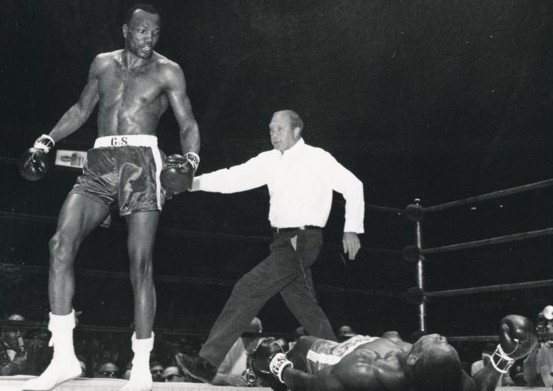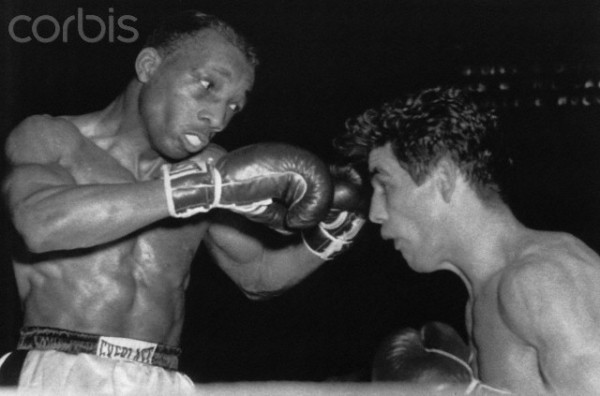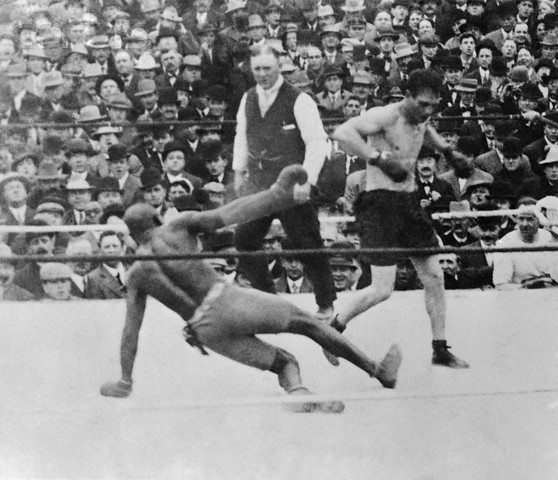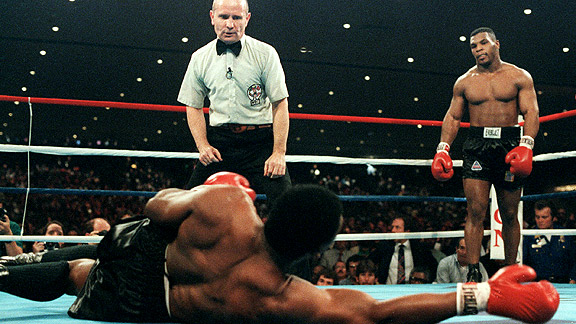
Photo by AFP/Getty Images
The Top 10 Hardest American Punchers
Boxing has a rich history of both famous and infamous characters, each a specialist in their own right. There is something about a fighter with crippling power that provides a white knuckle experience with each performance.
Regardless if the power puncher is desperately behind on points, there is a palpable sense that a dramatic finish may hang mere seconds away and keeps fight aficionados on the edge of their seats. Such endings leave spectators wandering from the arena (or couch) charged with excitement and already speculating who the slugger will face next and when.
Compiling and listing in order the top 10 such American men is no easy task. Initially,“The Boston Tar Baby” Sam Langford 179-30-39, 128 KOs made the list until it came to light that he is not from Boston at all, but born in Nova Scotia, Canada.
John L. Sullivan (38-1-1, 32 KOs) was also a strong contender for the list, but ultimately didn’t make the cut as the others showed consistent paralyzing power spanning far more career bouts.
The following list is a Murderer’s Row of the 10 most devastating punchers in U.S. fighters in boxing history.
Sound off in the comment section on who you think is the hardest American puncher of all time.
10. “The Ol’ Mongoose” Archie Moore
185-23-10, 131 KOs
Archie Moore (born Archibald Lee Wright) came into this world in Benoit, Mississippi on December 13, 1916–though the year is a subject of debate.
Moore boxed professionally from 1935 until he retired in 1963 at the ripe old age of 47. Moore won the Light Heavyweight Championship at 36 years old against Hall of Famer, Joey Maxim, defended it eight times–six by KO–and never lost it in the ring.
Moore was a very solid puncher whose power was greatly amplified by his uncanny ability to position himself with the proper angles and land flush. “The Ol’ Mongoose” also campaigned successfully as a heavyweight scoring numerous knockouts and dropped iron chinned Rocky Marciano with a short right hand in an unsuccessful bid for the Heavyweight championship.
Moore has both the distinction of scoring 131 knockouts, the most by any fighter in the history of the sport, and is the only boxer to face both Marciano and Cassius Clay aka Muhammad Ali.
Suggested viewing: Moore’s 1958 slugfest vs. Yvonne Durelle in which he was dropped three times in the first round, once in the fifth and came back to drop his opponent four times on way to a knockout victory.
9. Bob Foster
56-8, 46 KOs
Originally hailing from Borger, Texas Bob Foster first punched for pay in March of 1961with a knockout of Duke Williams in 2 rounds. Apparently everything truly is bigger in Texas as Foster boasted a freakishly tall Light Heavyweight frame of 6’3 and carried dynamite laden fists with him when he slid between the ropes.
Foster is widely accepted as one of the greatest Light Heavyweight champions to lace a pair of gloves. He won the title with a one punch knockout of very well-respected Dick Tiger in 1968. So devastating was the shot that Tiger hit the canvas flat on his back with a crushing impact that left an impression on all in attendance if not the ring floor itself. Foster went on to successfully defend his title 14 times, a record at that time.
Foster won the vast majority of his 175 pound bouts with similar conviction but had far different results in his multiple attempts to bring that stopping power to Heavyweight during the Golden Age of the division. In his two most famous attempts he was stopped by both Joe Frazier and Muhammad Ali.
Foster retired in 1978 and became a detective with the Bernalillo County Sheriff’s Department and was inducted into the Nevada Boxing Hall of Fame in 2015.
Suggested viewing: Bob Foster’s crushing, title winning knockout of Dick Tiger in 1968.
8. “The Manassa Mauler” Jack Dempsey
54-6-9, 44 KOs
William Harrison Dempsey was born in Manassa, Colorado in the early summer days of 1895. He grew up in squalor and left school at 16 years old to ride the rails and live in hobo camps. After finding success brawling for the entertainment of barroom patrons Dempsey elected to turn professional in 1914 under the name Jack Dempsey, a tip of the hat to former Middleweight fighter of the same namesake.
Dempsey’s early career had mixed results though 15 of his first 16 wins came by way of knockout. Dempsey needed to refine his skills but the power he carried in both hands was absolutely impossible to deny. Furthermore, he fought like a man who was demon possessed, raining devastating blows upon whoever was in front of his with reckless abandon.
After gaining some seasoning and a well-deserved reputation as a power-punching crowd pleaser, Dempsey found himself facing “Pottawatamie Giant,” Jess Willard who stood 6’6 ½” and tipped the scales at a solid 245 pounds.
The days of street fighting must have seemed far away to Dempsey as he stood across from the Heavyweight champion of the world in the blazing heat of July 4, 1919. The fireworks started early with Dempsey swarming Willard, dropping him seven times in the first round and stopping him in the third. The conclusion of the fight saw the now ex-champion with a broken jaw, ribs and teeth as well as multiple facial fractures.
After two defenses which he won via knockout, Dempsey faced France’s 50-1 underdog Georges Carpentier in boxing’s first million dollar gate, a testament to the drawing power of a relentless and aptly named “Mauler.”
Dempsey’s last successful defense was a torrid affair against Argentina’s Luis Firpo known as “The Wild Bull of the Pampas.” The furious first round saw Firpo hit the deck seven times and Dempsey twice, the second of which sent him through the ropes and onto the laps of the reporters at ringside. Dempsey rallied to stop Firpo in the 2nd.
Dempsey lost his title to Gene Tunney and his bid to regain it is now boxing lore. After being outboxed throughout the fight Dempsey let loose with a barrage that left Tunney on the deck. The neutral corner rule had been recently implemented and Tunney gained valuable time as referee Dave Barry struggled to get Dempsey to the proper corner. When Barry picked up the count Tunney rose and went on to outpoint Dempsey once again. Having been down for 14 seconds the fight is known as “The Battle of the Long Count.”
Suggested viewing: Jack Dempsey’s legendary slugfest with Luis Firpo in 1923.
7. Sandy Saddler
144-16-2, 103 KOs
Joseph “Sandy” Saddler was born New England tough in the city of Boston, Massachusetts in 1926. While he grew into a tall, lanky Featherweight he struck anything but the appearance of a fearsome puncher. The old boxing adage “punchers are born, not made” never rang more true than for Saddler.
While the United States was dropping bombs during World War II, Saddler started doing the same in 1944. He fought early and often leaving a wake of battered bodies and bruised egos in his wake while seldom sampling the bitter taste of defeat despite being stopped in his second professional fight.
His activity and exciting knockout style propelled him headlong to the Holy Grail of every fighter’s career, an opportunity to challenge for the world championship. He did just that in 1948 squaring off against the very formidable defensive master Willie Pep who boasted an impressive record of 134-1-1, 43 KOs and had never been stopped.
It was a classic matchup of the master, slick moving boxer against the aggressive, devastating puncher. In this case the puncher won the day scoring three knockdowns in the third and forcing Pep to take the full count in Round 4.
They fought a rematch just four months later within which time Saddler managed to reel off five more knockouts. In a fight that would be voted Fight of the Year by Ring Magazine, Pep dethroned Saddler via 15-round unanimous decision. He fought and defeated Pep twice more and regained his title, the final bout considered to be one of the most foul filled bouts in history with neither fighter considering rules or sportsmanship.
Saddler also won the Jr. Lightweight title in Havana, Cuba with a stoppage win over Diego Sosa in 1951. This fight was also wrought with dirty, roughhouse tactics by both fighters. At the end of the fight in Round 2, the crowd, sure the end was caused by a foul, began to riot.
Suggested viewing: Sandy Saddler’s power was on display in his 1954 fight against Bill Bossio.
6. “The Michigan Assassin” Stanley Ketchel
51-4-4, 48 KOs
Grand Rapids, Michigan welcomed Stanisław Kiecal as its newest resident on September 14, 1886. He was the son to Polish immigrants who traveled to the United States hoping for opportunity. They got exactly as they wished though perhaps not as they expected with Stanley Ketchel running away from home at age 12. He found his way to Butte, Montana and by age 16 he was fighting grown men in makeshift boxing matches for $20 per week. He grew his reputation with a ferocious, swarming style, punctuated with hands seemingly laced with iron.
Ketchel turned professional in 1903 with 38 of his first 39 victories coming by way of knockout. Quickly rising through the ranks he became the Middleweight Champion in 1908 via knockout and defended it twice with the same result before losing it to Billy Papke in the same year. Two months later he was champion again, regaining his title via 11th round knockout in a rematch.
Ketchel immediately tore into the Light Heavyweights which included two victories over Philadelphia Jack O’Brien, the first by 10-round Newspaper decision. So furious was the assault on O’Brien that at the end of the last round O’Brien was on his back unconscious when the final bell rang saving him from a knockout defeat. The same could not be said in the rematch when Ketchel overwhelmed him with slashing punches and stopped him in three, one-sided rounds.
The ever ambitious Ketchel wasn’t yet satisfied and ascended another weight division to challenge the Heavyweight champion of the world, Jack Johnson. It is long rumored that the two agreed to give the crowd an entertaining 20-round fight with a “no blood drawn” caveat.
Ketchel was knocked down and bloodied by the much larger “Galveston Giant” which ignited his usual frenzied attack. Ketchel jolted everyone in attendance, especially Johnson himself, when he unleashed a vicious shot in the 12th round that dropped the champion.
The shock was short lived however when Johnson rose deliberately from the canvas, surprised but unhurt and immediately dropped Ketchel in a heap. Johnson could be seen walking away from him brushing off several of Ketchel’s broken teeth that had embedded in his glove.
Ketchel lost a Newspaper decision to all-time great, Sam Langford (who incidentally recorded only three fewer career knockouts than KO king Archie Moore) before knocking out what turned out to be his three final opponents.
The last was a knockout in four over Jim Smith after which a laughing Ketchel bounded over the ropes in celebration, leaving the ring and disappearing through the crowd. Four months later an employee at a friend’s ranch murdered the 24-year-old Ketchel in a robbery gone awry.
Suggested viewing: Jack Johnson vs. Stanley Ketchel in a true David versus Goliath match.
5. “Iron” Mike Tyson
50-6 (2 NC), 44 KOs
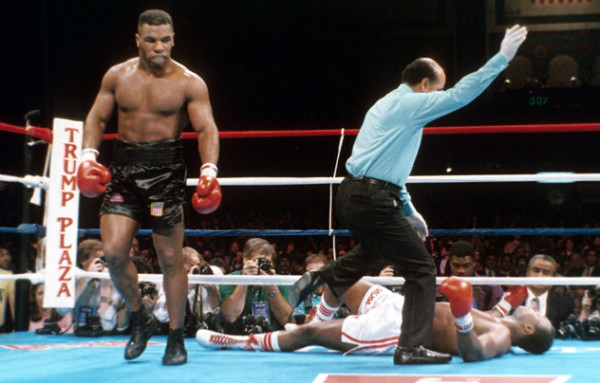
The Ring Magazine/Getty Images
Born in Brooklyn, NY in 1966, Mike Tyson’s life began as so many others born into poverty. When he was 10, Tyson moved to Brownsville with his mother and two siblings where he ran the streets and learned the thug life. By the time Tyson was 13 he had been arrested 38 times. He had a gentile side, which manifested itself with his love for raising pigeons which he did in makeshift pens on a New York roof top. This is where the legend of Tyson began when an older boy ripped the head off of one of his prized birds and Tyson beat him down in return.
After a successful amateur career Tyson turned professional in 1985 at the tender age of 18 with a first-round stoppage of Hector Mercedes. This began one of the most torrid, violent ascensions to the championship throne in history. Tyson reeled off 19 knockouts in as many fights with 12 in the first round before finally settling for a 10-round decision against veteran James “Quick” Tillis.
Tyson’s freneticc work rate, incredible hand speed and calamitous power cut through the field of contenders like a scythe laying waste to a wheat field. Under the tutelage of legendary trainer Cus D’Amato, Tyson entered the ring for a title shot in 1986. WBC Champion Trevor Berbick was a game veteran but simply overwhelmed by the irresistible force known as Tyson and was destroyed in two rounds making “Iron” Mike the youngest heavyweight champion at age 20.
Tyson added the IBF and WBA scalps to his saddle and was headed on a collision course with all-time great Light Heavyweight and Larry Holmes conqueror, Michael Spinks. It was a battle of undefeated champions and some were speculating it could be a reincarnation of the Ali-Frazier rivalry though that was a case of wishful thinking.
Tyson delivered a terrified Spinks his first career knockdown courtesy of a crushing body shot along the ropes just over a minute into Round 1. After gamely getting to his feet Spinks was immediately cratered by an atomic uppercut by Tyson ending the fight at the 91 second mark.
Mired by substance abuse problems that were later revealed and without the guidance of the deceased D’Amato, Tyson was stopped in a shocking upset by 48 to 1 underdog James “Buster” Douglas. Following that bout the wheels began to come off the Tyson express train. He became ensnared in issues both marital and legal.
Though Tyson continued his self-destructive lifestyle which began to show effects in the ring, he still wielded jolting, one-punch power that continued to thrill audiences. Such was the ferocity of Tyson that he garnered huge paydays and media attention that covered every moment of his rampaging meltdowns and expletive-filled orations. While he was never the same against elite competition the very name Tyson elicited excitement among fans worldwide who knew the fight could change with one shot.
4. “The Brockton Blockbuster” Rocky Marciano
49-0, 43 KOs
Rocco Francis Marchegiano was born in Brockton, Massachusetts to Italian immigrants in September of 1923. He grew up with his brothers playing baseball and dreaming of the Big Leagues until leaving school in the 10th grade and enlisting in the Army. It was there that Rocky Marciano began an amateur career that ended after hurting his hands in a knockout win over George McInnis in AAU Olympic tryouts.
In March of 1947 he traveled to Fayetteville, North Carolina to try out for the Fayetteville Cubs who were the farm team for the Chicago Cubs. He was sent packing after three weeks and returned home where he resumed boxing, turning professional in March 17 of the same year.
Marciano was historically one of the most physically disadvantaged Heavyweight champions standing only 5’10” and the shortage reach of any in history with 68″. He was clumsy, had terrible footwork and a crouch-and-club type style. He possessed, however, a will to win that very few in all of sport can even imagine. He also had a cement chin, inhuman stamina and pulverizing, one-punch power in either hand. If ever there was a seemingly regular guy from the neighborhood who made it big, it was Marciano.
He won his first 16 fights by knockout with nine of them in the first round. As he progressed he found himself in some competitive fights with his power making the difference and scoring a knockout or on occasion battering his opponent en route to a decision victory.
In 1951 Marciano was an underdog when he faced 37 year old all-time great Joe Louis. He pulled the upset, dropping Louis twice in the eigth round, the second of which sent the limp form of his childhood idol backward through the ropes. Lying on his back on the reporter’s ringside table and left foot still on the second rope referee Ruby Goldstein signaled the end of the fight.
Marciano challenged the wily 38-year-old veteran “Jersey” Joe Walcott for the Heavyweight championship in the fall of 1952. Walcott dropped Marciano heavily to a knee in the first round and steadily pulled away on the scorecards. Walcott continued boxing intelligently and showing Marciano angles, making him miss and countering effectively.
Going into the 13th round Walcott had a comfortable lead as Marciano pressed forward undeterred. With his back near the ropes Walcott set to throw a right while Marciano simultaneously threw his own. Marciano’s landed first with bone-crushing velocity and Walcott slowly slumped to the canvas. His head coming to rest on the canvas as he was counted out in a position looking much like someone in prayer.
Marciano defended the title against former champion Ezzard Charles in 1954. Close to being stopped with his nose gruesomely split down the middle and hopelessly behind on points Marciano’s power once again bailed him out and he scored an eight-round knockout in The Ring’s Fight of the Year.
With six successful title defenses, Marciano retired in 1955 as the undefeated Heavyweight champion of the world.
Suggested viewing: Rocky Marciano’s come from behind title winning battle with “Jersey” Joe Walcott in 1951.
3. “The Brown Bomber” Joe Louis
66-3, 52 KOs
Joseph Louis Barrow was a born Heavyweight tipping the scales at 11 pounds in LaFayette, Alabama on May 13, 1914. Louis’ family eventually left the poor southern, rural neighborhood when he was 12 and relocated to the district known as Black Bottom in Detroit, Michigan.
With The Great Depression hitting families with full force Louis opted out of street life and into boxing. He hid this from his mother and carried his boxing equipment in a violin case so that she wouldn’t find out. Eventually the truth came out and he was allowed to continue the sport in which he quickly excelled. Louis had a successful amateur career and eventually wining the United States Amateur Champion National AAU tournament in St. Louis, Missouri.
Louis had his first paid fight in Chicago in 1934. He scored a first-round knockout over Jack Kracken dropping him with a left hook. Upon gaining his feet, Louis sent him sprawling through the ropes and out of the ring. This victory set a precedent from which Louis did not stray as he trudged down an unsure a path toward the championship.
This was a period wrought with abject racism and America was still fuming at the perceived insolence of the flamboyant first and only Black Heavyweight champion, Jack Johnson who had been dethroned in 1915. Even though Louis was getting quality fights against respected contenders, the road to the championship was quite uncertain. His management advised him well, however and Louis was guardedly viewed as a humble, clean living man.
Rebounding from a shocking 12th round knockout loss at the hands of German and supposed Nazi sympathizer Max Schmeling, Louis strung together seven wins with six by stoppage. His management’s public relations strategy was a success and he met “Cinderella Man” James Braddock for the championship which he annexed with an eighth-round knockout.
Louis successfully defended the title three times with two by knockout before giving Schmeling the rematch for which the world was clamoring. With World War II in full swing and hatred of Nazi Germany internationally prominent the stakes of a prize fight had never been so great. It was East vs. West, Good vs. Evil, Black American vs. The Master Race. Louis unleashed a frightful beating upon the German, pulverizing him in the first round. Joe Louis became an American hero worshipped by millions and idolized children of all races.
Louis reigned over the heavyweight division for a record 11 years and 10 months. He also defended his championship against all contenders recording 25 title defenses, almost all coming by way of knockout. He retired as Champion in 1948 only to come back 2 years later. Louis retired for good in 1951.
2. “The Acorn” Earnie Shavers
74-14-1, 68 KOs
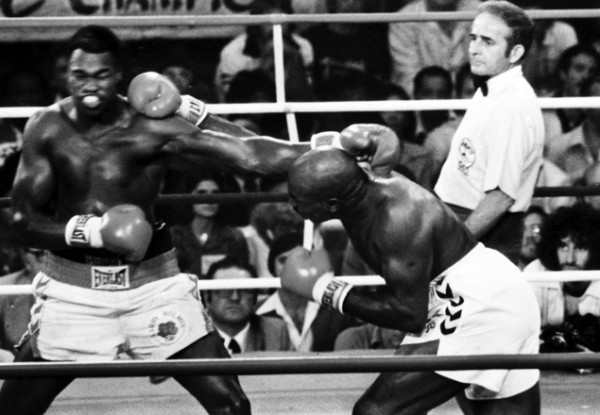
Photo by Ring Magazine/Getty Images
Earnie Shavers was born in Garland, Alabama in August of 1945. He didn’t have an extended amateur career though he did win the National AAU Heavyweight Championship in 1969. At 24 years old, Shavers elected to turn professional later that same year scoring a second round knockout.
Shaver’s unimaginable punching power was indisputable from the very beginning of his career winning 44 of his first 47 fights by knockout with 20 coming in the opening round. Through this period he put together a terrifying string of 27 consecutive knockouts.
Despite several setbacks that include stoppage losses, Shavers power made an impression on consumers and he was rewarded with a shot at the championship against Muhammad Ali in 1977. Shavers entered the ring prepared to make a statement as No. 1 contender Ken Norton commentated ringside for NBC. Shavers shook the iron chinned Ali to his boots with a nuclear right hand in the second round.
Ali exaggerated being hurt and Ernie, sensing a trap and not realizing how much trouble he was in didn’t press his advantage. It was an extremely close fight with Ali landing stinging combinations and Shavers detonating colossal shots on the Champion. The result was a razor thin unanimous-decision loss for Shavers.
Gaining further notoriety from his title shot, Shavers found himself on the cover of Sports Illustrated and soon after in the ring with Larry Holmes in a title-eliminator bout. He lost a clear decision but his name was firmly planted in the Heavyweight landscape. He won his next five fights by knockout including an overwhelming 1st round knockout of Ken Norton positioning him for a shot against recently crowned WBC Heavyweight King Larry Holmes.
In 1979 Shavers entered his last championship bout seeking revenge and the belt against Holmes. Shavers gave a spirited effort and came within a couple seconds of usurping the title when he dropped Holmes with an explosive right hand that left him in a heap and in deep trouble. Holmes rose groggily to his feet, shaking his head trying to clear the fog Shavers suddenly lowered upon him. He weathered the storm and stayed out of harm’s way until eventually turning the tables and stopping Shavers in the 11th.
Shavers continued fighting with moderate success with most wins coming inside the distance until retiring in 1983. He embarked on a couple of short, ill-fated comebacks and retired for good in 1995.
1. “Big” George Foreman
76-5, 68 KOs
George Foreman was born January 10, 1949 in Marshall, Texas. He was raised in a tough area called The Fifth Ward in Houston with six siblings and an aversion to the educational system. He was a naturally large youth and generally used his size to bully and intimidate those on his block. Foreman stopped going to school for good when he was 15 years old and eventually joined the Job Corps, which resulted in his relocation to California where he discovered boxing.
He had a relatively short amateur career of which he maximized winning a gold medal in the 1968 Olympics. Foreman garnered national attention when being awarded the gold medal as he waved a small American flag. This was polar opposite to some other medalists who had been raising a gloved fist in the air in a symbolic political statement.
Foreman joined the professional ranks in 1969 with a second-round stoppage victory. Keeping his eye on the top rung of the Heavyweight ladder and by 1971 Foreman slugged his way to an impressive record of 32-0, 29 KOs. He was now recognized as the No. 1 contender for Joe Frazier’s championship straps and a year later the fight Foreman had been waiting for came to fruition.
Frazier was the undefeated Heavyweight champion, an honor he punctuated with a unanimous-decision victory over the previously undefeated Muhammad Ali in The Fight of the Century. Foreman absolutely annihilated Frazier, dropping him six times before the fight was mercifully stopped in the second round.
After destroying Ken Norton in the first round with devastating uppercuts, Foreman was upset by Ali who was a huge underdog. Rebounding, he won his next five bouts by knockout including a thriller against Ron Lyle that saw both men on the canvas several times and a rematch with Frazier. In 1977, Foreman retired after losing a decision to Jimmy Young and having a life altering religious experience in his locker room after the fight.
Foreman returned to action 10 years later in a comeback virtually nobody took seriously. He feasted on fairly nondescript competition for two years when he started vaporizing fringe contenders. No one was laughing after Foreman put on a performance for the ages against the prim Evander Holyfield in 1991.
Three years later Foreman capitalized on his popularity and challenged reigning Heavyweight champion Michael Moorer. Foreman proved that power is the last thing to leave a puncher and at the age of 45, while hopelessly behind on points, Foreman detached the champion from his senses with an astounding right hand, regaining the title he lost 20 years earlier.
Suggested viewing: George Foreman’s effortless display of crushing power vs. Joe Frazier 1973.
